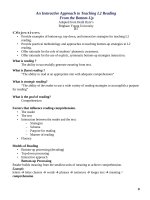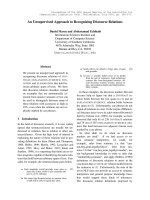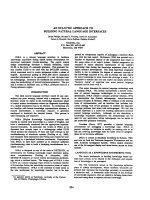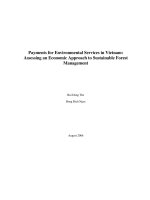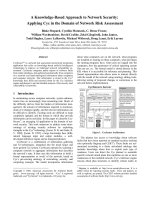Doctoral dissertation overview: Toward an attitude approach to predict entrepreneurial intention and test the role of entrepreneurship education and sources of capital - An empirical
Bạn đang xem bản rút gọn của tài liệu. Xem và tải ngay bản đầy đủ của tài liệu tại đây (671.78 KB, 27 trang )
MINISTER OF EDUCATION
UNIVERSITY OF ECONOMICS HCM CITY
--------------
TRAN QUANG LONG
DOCTORAL DISSERTATION OVERVIEW
“Toward an attitude approach to predict
Entrepreneurial Intention and test the role of
Entrepreneurship education and Sources of Capital:
an empirical research in Vietnam”.
Major: Business Administration
Code: 9340101
Ho Chi Minh City - 2018
1
Introduction
Entrepreneurship has been around since the 18th century and has
developed widely throughout the business world. Schumpeter (1934)
and Peter Drucker have an large contribution to the entrepreneurship
definition. Despite of some difference aspests, both Schumpeter and
Drucker believe that entrepreneurship is significantly important for
the overall economic health and point out some practical tools and
aspects of entrepreneurship so that one can become a successful
entrepreneur.
In the past couple of years, entrepreneurship has gained a lot more
attraction. Kelley, Singer and Herrington (2016) report that
entrepreneurship is thought to be a good career choice by more than
73% of Vietnamese people. As its economy emerges, young people in
Vietnam have seen an increase in perceived entrepreneurial
opportunities from 2013 to 2015 (36.8% to 56.8% respectively).
However, their entrepreneurial intention is significantly lower with
only about 22%. Despite the importance of entrepreneurship to
economic growth in Vietnam, there have not been many studies
conducted on this topic. Thus, the purpose of this study is to examine
the impacts of Entrepreneurial Attitude Orientations (EAO) on
Entrepreneurial Intention (EI) of Vietnamese adults. It also
investigates the moderating role of sources of capital on the
relationship between EAO and EI. This study will hopefully attract
scholars and practitioners’ attention because it expands the body of
knowledge of entrepreneurship field as well as provides practical
implications for the country’s lawmakers, financial institution
managers, and especially Vietnamese entrepreneurial mindsets.
2
Literature Review
Approaches to predict Entrepreneurship
Many authors
have
tried
different
approaches to
predict
entrepreneurship but there are two most common methods that
emerge, which are personality traits and demographic information.
Personality Traits Approach
There are certain authors who support the belief that personality traits
are important factors to determine whether a person will become an
entrepreneur such as kindness, need for achievement, locus of
control, risk taking, innovation, problem-solving style, tolerance for
ambiguity and values (Brockhaus, 1975; Brockhaus & Horwitz, 1986;
Collins & Moore, 1970; Hornaday & Aboud, 1971; Palmer, 1971;
Shapero, 1975; Swayne & Tucker, 1973). Despite having some
success, this approach reveals some problems in conception and
practice (Kilby, 1971; Klinger, 1966). It has been criticized by
a number of researchers as unsatisfactory and questionable in
explaining entrepreneurial conduct and performance (Gartner, 1988;
Aldrich & Zimmer, 1986, Low & Macmillan, 1988). Robinson et al.
(1991) argue that the methodologies used in those personality trait
studies were not built specifically for measuring entrepreneurship.
They find inconsistencies when many different scales were used to
measure a certain concept and believe that research efficacy would
be reduced when general measurements like personal traits are
applied to a specific and dynamic field.
Demographic Approach
Using demographic variables to study entrepreneurial intentions is
very popular throughout several decades. Factors such as birth,
3
gender, role models, age, education level, family background and
work habits are frequently used to develop a basic profile of
entrepreneurs (Gaddam, 2008). Kristiansen and Indarti (2004) find
several studies to support the argument that demographic variables
influence entrepreneurial goals. However, Robinson et al. (1991)
point out that this approach presents arguable problems and this
approach does not help to predict whether a person would be a
successful entrepreneur due to conflicting results (Bowen & Hisrich,
1986; Deivasenapathy, 1986; Hisrich, 1990). In addition, Garner
(1985) convinces that an average personal profile of entrepreneurs
cannot be built because entrepreneurs create an exceedingly
heterogeneous group of people.
Toward a new approach: the attitude approach
Since both approaches receive criticism for their methodological and
conceptual limitations (Ajzen 1991; Gartner 1989; Low &
MacMillan, 1988; Santos & Liñán 2007; Shapero & Sokol 1982), a
better approach deems necessary. Krueger, Reilly, and Carsrud (2000)
argue that the decision to become an entrepreneur may be considered
as voluntary and conscious so understanding about how that decision
takes place and what factors effect an individual’s mind is very
important. From this sense, the entrepreneurial intention is perceived
as a decisive antecedent of entrepreneurial behaviours (Fayolle &
DeGeorge, 2006; Kolvereid, 1996). Ajzen (1991) states that “the
intention of carrying out a given behaviour will depend on the
person’s attitudes towards that behaviour.” The more favourable the
attitudes are, the more plausible the intentions are. Hence, an
“attitude approach” would be more suitable than personal traits or
4
demographic factors (Krueger et al., 2000; Robinson et al.,1991).
Robinson et al. (1991) develop the Entrepreneurial Attitude
Orientation (EAO) scale which relies on attitude theory and is
specifically designed to predict entrepreneurship.
Entrepreneurial Intentions
Entrepreneurial intentions (EI) is defined as “an individual’s
desire to create their own business” (Crant, 1996) or “to start a
business” (Krueger et al., 2000). Thompson (2009) defines EI as
“self-acknowledged conviction by a person that they intend to set up
a new business venture and consciously plan to do so at some point
in the future”. Intentions have been used to describe self- prediction
to engage in behaviour; “the stronger the intention is, the more
probable the behaviour is” (Ajzen, 1991; Ajzen & Fishbein, 1980).
Social-psychological studies assume that intention is the sole
predictor of actual behaviour (Bagozzi, Baumgartner, & Yi, 1989;
Armitage & Conner, 2001). Despite of that, some scholars suspect
whether intentions truly predict actual entrepreneurial behaviour
(Douglas & Shepherd, 2002). However, multiple studies still find
entrepreneurial intentions as one of the crucial antecedents of actual
entrepreneurial behaviours and actions (Bird, 1988; Fayolle &
DeGeorge, 2006; Krueger & Carsrud, 1993; Kolvereid, 1996; Lee,
Wong, Foo, & Leung, 2011; Tkachev & Kolvereid, 1999).
Entrepreneurial Attitude Orientation (EAO)
Attitude is defined as the predisposition to respond in a generally
favourable or unfavourable manner (Ajzen, 2005; Rosenberg &
Hovland, 1960; Shaver, 1987). Although there are several attitude
approaches such as TPB (Ajzen, 1991), EEM (Shapero & Sokol,
5
1982), Robinson et al. (1991) develop the EAO scale which contains
four subscales. Each subscale consists of three attitude components
including Affection, Cognition, and Conation (also referred to as the
behavioural component). According to Robinson et al. (1991), “the
larger the value of each subscale is, the higher the ability to predict
entrepreneurial individual is.” Huefner, Hunt, and Robinson (1996)
affirm that the EAO successfully distinguished entrepreneurs and
non- entrepreneurs in several studies. Robinson et al. (1991) applied
the tripartite model, included three types of reaction to everything:
affect (AFF_consists of positive or negative feelings toward the
object), cognition (COG_ consists of the beliefs and thoughts an
individual has about an attitude object), and conation or behavioral
(BEH_ consists of behavioral intentions and predispositions to
behave in a given way toward the object). Using the attitude
components in the EAO research would enhance the content validity
of each subscale (Huefner et al., 1996).
6
Figure 1. Entrepreneurial Attitude Orientation (EAO)
Achievement
Self-esteem
Cognition
Affection
Attitude
Conative
Innovation
Personal Control
Self-esteem
The concept of self-esteem has been variously defined in the
literature. Crandall (1973) defines self-esteem as “linking and
respecting of oneself which has some realistic basic” (p.45).
Coopersmith (1981) believes that self-esteem is “an impression of
approval or disapproval, indicating the extent to which a person’s
belief for himself or herself is competent, successful, significant and
worthy” (Coopersmith, 1981). While many authors believe that selfesteem does not affect entrepreneurial behaviour (Moradi and
Razaviyayn, 2013; Moradi, 2010), there are many studies confirm
self-esteem is the most important characteristic of entrepreneurs
(Pyszczynski, Solomon, Greenberg, & Arndt, 2004) Cunningham et
al., 2005; Ji, Lapan, & Tate, 2004; Johnson, Stone, & Phillips, 2008).
In other words, there is still unconsistent result bout self-esteem in
entrepreneurship. With that being said, the following hypothesis is
proposed:
7
H1:
Self_esteem
(H1.1:
SE_AFF;
H1.2:
SE_COG;
H1.3:
SE_BEH) positively impacts entrepreneurial intention.
Innovation
Innovation is defined as “a process that involves the generation,
adoption, implementation and incorporation of new ideas, or
practices within an organization” (Van de Ven et al., 1989).
According to OECD and European Commission (1997), innovation
means completing products and services by developing them
technologically (as cited in Gündoğdu, 2012). Damanpour and
Gopalakrishnan (2001, p.47) define innovation as “the adoption of an
idea or behaviour pertaining to a product, service, device, system,
policy, or program that is new to the adopting organization.”
Innovation has traditionally been linked to entrepreneurship
(Schumpeter, 1934). Many researchers have emphasized
the
relevance of innovation for businesses (e.g., Hsueh & Tu, 2004;
Freel, & Robson, 2004). In Gündoğdu’s opinion, under the
environment
of
advanced
information
and
communication
technology, with the trend of globalization, entrepreneurs and
enterprises were forced to respond to customers and adapt to the
environment more quickly. Innovation was an essential element for
entrepreneurs to stay in business (Gündoğdu, 2012). With that being
said, the following hypothesis is proposed:
H2: Innovation (H2.1: INN_AFF; H2.2: INN_COG; H2.3:
INN_BEH) positive impacts entrepreneurial intention.
Personal control
According to Seeman (2008), “Personal control beliefs, also
referred to as locus of control and personal mastery beliefs, reflects
individuals' beliefs regarding the extent to which they are able to
8
control or influence outcomes.” According to Rotter’s model, the
locus of control of an individual includes internal and external control
(Rotter, 1966). Many researchers believe that internal controls are
typically associated with entrepreneurial characteristics
(e.g.
Brockhaus, 1982; Cromie & O'Donoghue, 1991; Kaufman &
Welsh, 1995; NiitKangas et al., 1994; Perry, 1990; Shaver &Scott,
1991). However, Schjoedt (2008) finds inconsistent and conflicting
results when it comes to research on locus of control and
entrepreneurship (e.g., Cooper & Gimeno- Gascon, 1992). With that
being said, the following hypothesis is proposed:
H3: Personal Control (H3.1:PC_AFF; H3.2: PC_COG; H3.3:
PC_BEH) positive impacts entrepreneurial intention.
Achievement
In the previous years, many factors such as money, wealth,
power, name, fame, and achievement, have been studied as a source
of entrepreneurial motivation (Drucker, 1964; McGregor, 1960,
1966; McClelland, 1981, 1987). Researchers also find that human
needs and motives have an impact on one’s motivation during work
(Maslow, 1943, 1954; McGregor, 1960, 1966). Need for achievement
is defined as the “desire to do well and to attain an inner feeling of
personal accomplishment” (McClelland, Atkinson, Clark, & Lowell,
1953). Lee and Chen (2012) find that achievement motivation has
a
significant
influence
on entrepreneurial behaviour “once the
motivation of running their own business overwhelms, they would
choose to pursuit their desire by running their own business” (Lee
and Chen, 2012). Many authors agreed with that there is a positive
correlation between achievement motivation and entrepreneurship
(Jayeoba, Sholest, and Lawal, 2013;
Ahmed, 1985; Garland et
9
al.,2003; Jayeoba et al., 2013). With that being said, the following
hypothesis is proposed:
H4: Achievements (H4.1: ACH_AFF, H4.2: ACH_COG; H4.3:
ACH_BEH)
positive
impacts
entrepreneurial
intention.
Entrepreneurship education
Entrepreneurship
education
consists
of
“any
pedagogical
[program] or process of education for entrepreneurial attitudes and
skills” (Fayolle, Gailly, & Lassas-Clerc, 2006b, p. 702). It has a
relatively long history and has developed into a widespread
phenomenon (Katz, 2003; Kuratko, 2005). However, as we found in
literature researchers usually focus on different types of
entrepreneurship education which targeted toward particular stages
of development (Bridge, O’Neill, & Cromie, 1998; Gorman, Hanlon,
& King, 1997; McMullan & Long, 1987) or specific audiences
(Jamieson, 1984; Liñán, 2004).
Method
of
Entrepreneurship
education:
Several
different
pedagogical designs for entrepreneurship education have been used
ranging from business plans to guest speaker or venture creation (cf.
Kuratko, 2005). There are still arguments from author for the most
positive method.
H5: Method of entrepreneurship education has a difference impact
to (H5.1) self_esteem, (H5.2) innovation, (H5.3) personal control,
(H5.4) achievement and (H5.5) entrepreneurial intention.
Duration of Entrepreneurship Education. Schools usually offer
entrepreneurship education in a various duration from a workshop to
a semester. The main difference is the level of absorpting for student
between class
meetings.
As
such,
we
argue
that
when
10
entrepreneurship education is taught in difference durarion would
make a difference impact in entrepreneurial intention.
H6: duration of entrepreneurship education has a difference impact
to (H6.1) self_esteem, (H6.2) innovation, (H6.3) personal control,
(H6.4) achievement and (H6.5) entrepreneurial intention.
Level of student’s education. Christopher Schlaegel and Michael
Koenig (2013) showed in a meta-analysic that most of
Entrepreneurship education research were taken placed in
universities ( for example : Zhang et al, 2013 ; Wurthmann, K.
(2013), Wagner, M. (2011), Santos & Liñán, 2010). While there is
little studies in other level of education such as Diploma or Master,
we believe that by comparing the impact of students level to
entreprenuerial intention would be potential.
H7 : level of student’s education has a difference impact to
(H7.1) self_esteem, (H7.2) innovation, (H7.3) personal control,
(H7.4) achievement and (H7.5) entrepreneurial intention.
Sources of Capital
Sources of capital are among factors that are believed to be very
critical in increasing the rate and nurturing of new venture
developments (Pennings, 1982). Higher income and wealth levels
can enhance entrepreneurial processes thanks to the availability of
higher capital expenditure (Bergmann, 2005), higher demand for
products (Bosma, van Stel, & Suddle 2008; Reynolds, Storey, &
Westhead, 1994), and a greater supply of resources for business
capitalization and lower borrowing costs (Bates, 1995; Kangasharju,
2000; Stam, 2010). People who have more savings and assets may
have less risk of insecure self- employment (Ashcroft, Love, &
Malloy, 1991; Kangasharju, 2000) and these savings and assets can
11
be used as important collateral for bank loans (Black, de Meza, &
Jeffreys, 1996).
From the financial perspective, Myers (1984) distinguished sources
of capital as the internal and external finance. Lately, Kovačić (2011)
argued to have three kinds of sources capital include: saving, loan and
investment.
Bank loan
Åstebroa and Bernhardt (2003) conclude that bank loans are highly
and positively correlated with start-up sustainability. Brezak Brkan
(2010) states that private investors play a very popular role in
providing financial resources for entrepreneurs by providing capitals
to businesses that have potentials for success. In their study in UK,
Sharpe, Cosham, Connell and Parnell (2009) confirm the important
role of business angels to high-tech start-ups from the very early
beginning.
Saving:
When planning for a start-up, founders first rely on internal financing
sources such as savings, funds from friends and family, and then
external financing sources such as borrowing bank loans and business
angels (Krishnan, 2010). It reveals that entrepreneurs tend to believe
in their decision and their families and fools are willing to support
them.
Investment
Rakar (2006) mentions the importance of venture capital investments
as a shared ownership of a start-up. Entrepreneurs may seek capital
investments from individuals, companies or funds in exchange for
ownership of the company as “shareholders.” Samila and Sorenson
12
(2011) agree that venture capital effects greatly on regional rates of
entrepreneurship in the U.S. Popov and Roosenboom (2013) find that
venture capital investment positively impacts the rate of new
businesses in several countries in Europe.
Studies usually focus on clarifying kinds of source of capital or
stages. There is an absent of research on the role of sources of capital.
With that being said, the following hypothesis is proposed:
H8: Sources of capital moderates the relationship between (H8.1)
Self_esteem; (H8.2) Innovation; (H8.3) Personal control; (H8.4)
Achievements and entrepreneurial intention.
Figure 2 shows the initial research model.
Education
Methods: H5
Duration: H6
Level of education: H7
H1.1
H 5.1
H 6.1
H 7.1
Selfesteem
(SE)
AFF
COG
BEH
H 5.5
H 6.5
H 7.5
H1.2 H1
H1.3
H2.1
H 5.2
H 6.2
H 7.2
Innovat
ion
(INN)
AFF
COG
BEH
H2.2 H2
H2.3
Entrepren_
eurial
intention
H3.1
H 5.3
H 6.3
H 7.3
Personal
Control
(PC)
AFF
COG
BEH
(EI)
H3.2 H3
H3.3
H4.1
H 5.4
H 6.4
H 7.4
Achieve
ment
(ACH)
Impact
AFF
COG
BEH
H4.2 H4
H4.3
H8.1
H8.4
Moderate
H8.2
H8.3
Sources of capital
Control
13
Methodology and Analysis
Sampling
A convenience sample was drawn to collect data in this study. The
target audience was Vietnamese adults who are 17 years old and older
and reside the three largest cities including Ha Noi, Da Nang, and Ho
Chi Minh. Participants were selected from entrepreneurship programs
and universities. The self- administered survey method was adopted,
which reduces the subjectivity errors. This technique was appropriate
in Vietnam to encourage people to participate in this kind of survey
(Nguyen, 2011). The original questionnaire was written in English and
translated into Vietnamese by a person who was not familiar with the
topic. It then went through a serious back translation procedure to
insure the validity of instrument and was confirmed that there was no
significant difference between the original version and the backtranslate version. The questionnaires were delivered to respondents
via emails using Google drive in addition to 500 hard copies version
which were hand delivered. The purpose of the study, informed
consent, procedure of maintaining confidentiality, and instructions on
how to complete the survey successfully were included in a cover
letter. 441 copies were received and after eliminating invalid copies,
337 were used for the analysis. As seen in Table 1, the number of
female respondents was slightly higher than that of male respondents
(51.9% and 48.1% respectively) and majority of respondents were
under 36 years old (93.2%). In addition, 78% of respondents were in
a 4 year college program.
Table 1: Demographic Variable (n = 337)
Tiêu chí
Valid
Percent
Valid
Percent
Cumulative
Percent
14
Gender
Male
Female
17-25
26-35
36-45
>45
High school
College
Barchelor
Master
Age
Level of
education
162
175
223
91
17
6
48
16
263
10
48.1
51.9
66.2
27.0
5.0
1.8
14.2
4.7
78.0
3.0
48.1
51.9
66.2
27.0
5.0
1.8
14.2
4.7
78.0
3.0
48.1
100.0
66.2
93.2
98.2
100.0
14.2
19.0
97.0
100.0
Measurement Scale
Entrepreneurial Attitude Orientation (EAO)
Robinson et al. (1991) designed the entrepreneurial attitudes
orientation (EAO) which comprises 75 items. The scale includes four
subscales: Achievement (ACH) (23 items, Cronbach’s α =.84),
Personal Control (PC) (12 items, Cronbach’s α = .70), Innovation
(INN) (26 items, Cronbach’s α = .90), and Self- Esteem (SE) (14
items, Cronbach’s α = .73). The EAO scale has been widely used by
previous researchers to quantify attitudes toward entrepreneurship
(Boshoff & Scholtz, 1995; Harris & Gibson, 2008; Sharif &
Saud,
2009;
Stimpson,
Huefner, Narayanan, & Shanthakumar,
1993; Wyk & Boshoff, 2004). In this study, we used the 7-point
Likert scale to measure the entrepreneurial attitude in Vietnam
with
a
higher
score representing a strong entrepreneurship
orientation.
Entrepreneurial Intentions (EI)
This study used Linan and Chen (2009)’s 6-item Entrepreneurial
Intentions (EI) scale which is behavioural-intention-oriented. Each
15
item was measured on a 7-point Likert scale with a higher score
representing a strong entrepreneurship intention.
Reliability
To ensure the reliability of measurement scales, the authors
computed several measures of internal consistency. First, Cronbach’s
alpha coefficient for a given construct was calculated. To see whether
individual items within the construct are poorly correlated with
others, we also assessed item-total correlation of each item (i.e., one
between it and the sum of the remaining instruments) and Cronbach’s
alpha with the item deleted. Table 2 showed the final reliability test
results of all scales.
Table 2: Reliability
Scale Mean
Scale
if Item
Variance if
Deleted Item Deleted
SE_AFF1
18.61
26.025
SE_AFF2
18.18
23.546
SE_AFF3
18.14
22.535
SE_AFF4
18.82
25.562
SE_AFF5
17.91
23.653
Cronbach's Alpha = .746 (N=5)
SE_COG1
10.98
5.904
SE_COG2
11.12
6.863
SE_COG4
10.82
7.028
Cronbach's Alpha = .757 (N=3)
PC_AFF2
5.91
1.597
PC_AFF3
5.65
1.733
Cronbach's Alpha = .803 (N=2)
PC_BEH1
15.16
10.591
PC_BEH4
15.82
11.143
PC_BEH5
15.65
9.426
PC_BEH6
15.37
9.323
Cronbach's Alpha = .712 (N=4)
PC_COG2
5.24
2.296
PC_COG3
5.09
2.216
Corrected
Item-Total
Correlation
.415
.561
.594
.435
.547
Cronbach's
Alpha if Item
Deleted
.735
.682
.668
.728
.688
.638
.591
.536
.614
.671
.730
.680
.680
.a
.a
.431
.391
.573
.607
.689
.710
.601
.580
.486
.486
.a
.a
16
Cronbach's Alpha = .654 (N=2)
ACH_AFF3
17.16
ACH_AFF5
17.14
ACH_AFF6
17.19
ACH_AFF7
17.04
Cronbach's Alpha = .858 (N=4)
ACH_COG3
27.36
ACH_COG4
27.37
ACH_COG5
27.53
ACH_COG6
27.56
ACH_COG7
27.52
ACH_COG8
27.76
Cronbach's Alpha = .857 (N=6)
ACH_BEH1
25.56
ACH_BEH2
25.36
ACH_BEH3
25.40
ACH_BEH4
25.03
ACH_BEH5
24.98
ACH_BEH6
25.13
Cronbach’s Alpha = .808 (N=6)
INN_AFF3
16.32
INN_AFF7
15.91
INN_AFF8
16.13
INN_AFF9
16.32
Cronbach's Alpha = .752 (N=4)
INN_COG1
30.48
INN_COG2
30.79
INN_COG3
30.18
INN_COG5
30.09
INN_COG6
30.57
INN_COG7
30.58
INN_COG9
30.23
Cronbach's Alpha = .797 (N=7)
INN_BEH1
23.40
INN_BEH2
23.74
INN_BEH3
23.75
INN_BEH4
23.34
INN_BEH5
23.10
INN_BEH6
22.86
Cronbach’s Alpha = 0.732 (N=6)
EI1
28.17
11.147
11.751
11.148
11.501
.654
.728
.730
.708
.842
.811
.808
.817
27.721
27.788
28.661
28.932
30.119
30.991
.718
.726
.647
.689
.587
.508
.819
.817
.832
.825
.843
.857
22.384
21.845
21.569
21.868
21.401
22.031
.442
.583
.575
.612
.650
.558
.808
.774
.776
.768
.759
.779
10.092
10.110
9.009
8.842
.453
.510
.658
.583
.746
.715
.634
.675
31.054
32.424
31.331
31.854
31.401
32.381
31.756
.539
.487
.590
.542
.494
.518
.525
.769
.778
.760
.768
.778
.773
.771
22.431
20.994
22.463
21.672
23.671
22.968
.439
.502
.440
.546
.431
.444
.703
.684
.702
.671
.704
.700
32.020
.628
.883
17
EI2
27.81
EI3
27.78
EI4
27.92
EI5
27.65
EI6
27.72
Cronbach's Alpha = .889 (N=6)
30.478
31.293
30.600
32.538
33.448
.771
.759
.747
.719
.622
.859
.862
.863
.868
.883
Factor Analysis
Independent variables
KMO and Barlett’s Test and Exploratory Factor Analysis (EFA)
were used for factor loading analysis on independent variables. The
value of KMO=.850 at p=.000 so we can move forward with EFA.
In the EFA results, the Eigenvalues at the 9th component was
1.095 (>1) while the Eigenvalues at the 10th component was .978
(<1). Therefore, 9 components were taken with the cumulative
percentage of 59.932%. The EFA was appropriate.
In the component matrix, we can see ACH_AFF and PC_AFF were
combined into ACHPC_AFF, and PC_COG and ACH_COG were
combined into ACHPC_COG because they were loaded on the same
factor.
Table 4: EFA result
Factor
Achievement
Personal
control
ACHPC
ACHPC_AFF
ACHPC_COG
Items
ACH_AFF3
ACH_AFF5
ACH_AFF6
PC_AFF3
PC_AFF2
PC_COG3
ACH_COG7
ACH_COG6
Factor
Loading
.735
.708
.660
.607
.501
.685
.598
.595
18
Tự trọng
SE
SE_AFF
SE_COG
Innovation
INN
INN_COG
INN_AFF
INN_BEH
Achievement
ACH
ACH_BEH
Personal
Control
PC
PC_BEH
Dependent variable
PC_COG2
ACH_COG8
ACH_COG5
SE_AFF1
SE_AFF2
SE_AFF3
SE_AFF4
SE_AFF5
SE_COG1
SE_COG2
INN_COG1
INN_COG2
INN_COG3
INN_COG6
INN_COG7
INN_AFF3
INN_AFF8
INN_AFF9
INN_BEH1
INN_BEH2
INN_BEH3
INN_BEH4
ACH_BEH1
ACH_BEH2
ACH_BEH3
PC_BEH4
PC_BEH5
PC_BEH6
.564
.556
.547
.626
.728
.769
.650
.720
.738
.794
.720
.741
.610
.577
.578
.689
.591
.660
.581
.763
.743
.697
.765
.727
.581
.638
.819
.640
19
KMO and Barlett’s Test and Exploratory Factor Analysis (EFA)
were used for factor loading analysis on dependent variable.
KMO=.896 at p=.000 so we can move forward with EFA.
Table 5 showed that the dependent variable EI was loaded on one
factor and accounted for 64.713% of variance. Therefore, the EFA
was appropriate.
Figure 3: Adjusted research model
H 6.1
H 7.1
H 8.1
H 6.2
H 7.2
H 8.2
Self_este
em
(SE)
AFF
COG
AFF
Inno_vat
ion
(INN)
COG
BEH
H 6.3
H 7.3
H 8.3
Personal
Control
(PC)
H 6.4
H 7.4
H 8.4
Achieveme
nt
(ACH)
H 6.5
H 7.5
H 8.5
Achievem
entPersonal
control
ACHPC
Impact
H1.1
Education
Methods: H6
Duration: H7
Level of education: H8
H 6.6
H 7.6
H 8.6
H1
H1.2
H2.1
H2.2
H2
H2.3
Entrepren_
H3
BEH
eurial
intention
(EI)
H4
BEH
AFF
H5.1
H5
H5.2
COG
H9.1 H9.2 H9.3 H9.4
H9.5
Source of capital
Moderate
Control
20
Result
Relationship between EAO and EI
The correlation matrix showed the correlations among variables. All
independent variables were significantly correlated to the dependent
variables. Thus, a regression analysis was appropriate. In addition,
there
was
no
significant
correlation
among independent
variables except for SE_AFF and ACHPC_AFF (p=.01<.05).
However, Pearson correlation was rather small (.176).
Table 6 showed regression results. P-value was .000 which was
significant. ACHPC_AFF, ACH_BEH, INN_AFF, INN_BEH, and
INN_COG had a significant impact on EI at p<.05. ACHPC- AFF had
the strongest impact (β=.302), followed by ACH_BEH (β=.167),
INN_AFF (β=.141), INN_COG (β=.108), and INN_BEH (β=.107).
Therefore, Hypotheses H2.1, H2.2, H2.3, H4, and H5.1 were
supported. SE_COG (β=.081) and PC_BEH (β=.077) had a
significant impact on EI at p<.10. Therefore, H1.2 and H3 were
supported. Other variables had no significant impact on EI. As a result,
H1.1 and H5.2 were not supported.
EI = (-0.178) + 0.043 SE_AFF + 0.068 SE_COG + 0.079
PC_BEH + 0.329 ACHPC_AFF + 0.179 ACH_BEH + 0.015
ACHPC_COG + 0.148 INN_AFF + 0.113 INN_BEH + 0.131
INN_COG.
Table 6: Regression Results (EAO on EI)
21
Coefficientsa
Unstandardize Standardized
d Coefficients Coefficients
B
(Constant)
SE_AFF
SE_COG
PC_BEH
ACHPC_AFF
ACH_BEH
ACHPC_COG
INN_AFF
INN_BEH
INN_COG
Std.
Error
-.178
.043
.068
.079
.329
.179
.015
.148
.113
.131
Collinearity
Statistics
Beta
.374
.038
.039
.048
.067
.050
.066
.053
.045
.060
t
.046
.081
.077
.302
.167
.013
.141
.107
.108
-.476
1.118
1.749
1.653
4.937
3.587
.225
2.784
2.488
2.180
Tolera
nce
Sig.
.635
.264
.081
.099
.000
.000
.822
.006
.013
.030
.957
.753
.739
.429
.745
.477
.626
.866
.653
VIF
1.045
1.328
1.352
2.329
1.342
2.097
1.597
1.155
1.531
a. Dependent Variable: EI
Role of Entrepreneurship education
We apply ANOVA and Post hoc test to examine the impact of
methods, duration and level of education to EAO and EI.
-
Method of education is confirmed to impact EAO through Selfesteem ang Innovation. Guest speaker, Theory combine internship,
Video/game are more positive impact than Theory or case study.
Hence, Hypothesis H6.1, H6.2 are accepted.
-
Duration of programs is confirmed to impact Achievement Personal
control and Innovation as well as increase EI. Hypothesis H7.2, H7.5
and H7.6 are accepted.
-
Level
of
education
is
confirmed
to
impact
Self-esteem,
Innovation, Achievement Personal control and EI. People who have
22
Diploma degree have higher entrepreneurial intention compared with
other. Hypothesis H8.1, H8.2, H8.5 and H8.6 are accepted.
Moderating role of sources of capital
Table 7 showed the regression analysis with 2 dummy variables
namely sharing and borriwing. P-value was .000 which was
significant. Kinds of saving, borrowing and sharing have a moderated
impact to the relationship between EAO and EI. In detail, saving has
a strongest positive impact through ACHPC_BEH (β=0.091),
ACHPC_AFF
(β=0.341),
ACH_BEH
(β=0.240),
INN_AFF
(β=0.146), INN_COG (β=0.115) and INN_BEH (β=0.157). Both
kinds of borrowing and sharing have positive impact on SE_AFF and
negative impact on ACH_BEH. To sum up, sources of capital have
moderated impact to the relationship between EAO and EI and
hypothesis H9.1, H9.2, H9.3, H9.4 and H9.5 were accepted.
Table 7: Regression result of sources of capital
Coefficientsa
Unstandardiz
ed
Standardized
Coefficients Coefficients
Std.
Erro
B
r
Beta
(Constant)
SE_COG
PC_BEH
ACHPC_AFF
ACH_BEH
INN_AFF
INN_BEH
INN_COG
SE_COG_vay
ACH_BEH_vay
SE_COG_đầu tư
ACH_BEH_đầu tư
a. Biến phụ thuộc: EI
-.093
-.006
.091
.341
.240
.146
.115
.157
.166
-.148
.244
-.235
.344
.043
.047
.061
.054
.052
.045
.059
.082
.089
.073
.081
Collinearity
Statistics
t
-.270
-.008 -.147
.089 1.949
.313 5.593
.223 4.422
.139 2.785
.110 2.565
.130 2.674
.290 2.007
-.243 -1.662
.412 3.361
-.356 -2.891
Sig.
.787
.883
.052
.000
.000
.006
.011
.008
.046
.097
.001
.004
B
Std.
Error
.582 1.718
.746 1.340
.496 2.018
.610 1.640
.627 1.595
.851 1.175
.660 1.516
.074 13.436
.073 13.699
.104 9.649
.103 9.736
23
A: Borrowing
B: Sharing
To compare the moderating role between sources of capital, we
applied comparing regression weight:
Table 8: regression weight comparing
Regression weight
Saving
Borrowing
Sharing
SE_COG
(-0.06)
0.166
0.244
ACH_BEH
0.240
(-0.148)
(-0.235)
As table 8, sharing has the strongest possitive impact on
SE_COG compare with borrowing and saving. In contrast, saving has
the strongest possitive impact to ACH_BEH difference with sharing
to have strongest negative impact.
Discussion and Managerial Implications
It appears that Robinson et al. (1991)’s EAO model was an
appropriate scale to measure EI. However, there was a change in
components: perceived Personal Control (PC) and perceived
Achievement (ACH) were loaded into Conation (COG) and
Affection (AFF) to create the new component namely Achievementpersonal control (ACHPC). Ismail (2013) also found only three
factors (Personal Control, Self-Esteem, and Innovation) that had
significant impacts on entrepreneurial intention. Vietnamese adults’
Entrepreneurial Intention was impacted by their Entrepreneurial
Attitude Orientations through Self-Esteem, Personal Control,
Innovation, and Achievement. In other words, people with high selfesteem tend to have high entrepreneurial intention. Those who
believe that they are able to control or influence outcomes seem to
have a higher entrepreneurial intention. People with innovative
24
mindsets appear to be more willing to take on entrepreneurial
opportunity that may present to them. Finally, those who have a high
need for achievement, i.e., strong desire to do well and strong feeling
of personal accomplishment (McClelland et al., 1953), are more
likely to possess a high intention to pursue entrepreneurial
opportunities.
This confirms that attitude approach to entrepreneurship research is
more appropriate than other traditional approaches (Krugeger et al.,
2000; Robinson et al., 1991). It also supports Ajzen (1991)’s
belief that the intention to act depends on the attitude toward that
behaviour. The stronger the attitude toward entrepreneurship,
the stronger the entrepreneurial intention. The findings of this study
support Fitzsimmons and Douglas (2005)’s research in India, China,
Thailand and Australia. Entrepreneurship eduction is confirmed to
have impact on EAO and EI. Methods like guest speaker, theory
combine with intership, game and video have a positive impact to
EI compare with theory and case study. Duration of programs should
be from 11-20 classes. People who have Diploma degree tend to have
highest entrepreneurial intention.
Sources of capital is confirmed to moderate the relationship between
Entrepreneurial Attitude Orientation and Entrepreneurial Intention.
Given the positive impact of sources of capital on the
entrepreneurial
intention, Vietnamese lawmakers should create
policies that support the availability of sources of capital and
encourage more Vietnamese adults to embark on the entrepreneurial
journeys.
Financial
institutions,
investment
funds,
and
entrepreneurial support centres should encourage entrepreneurial


